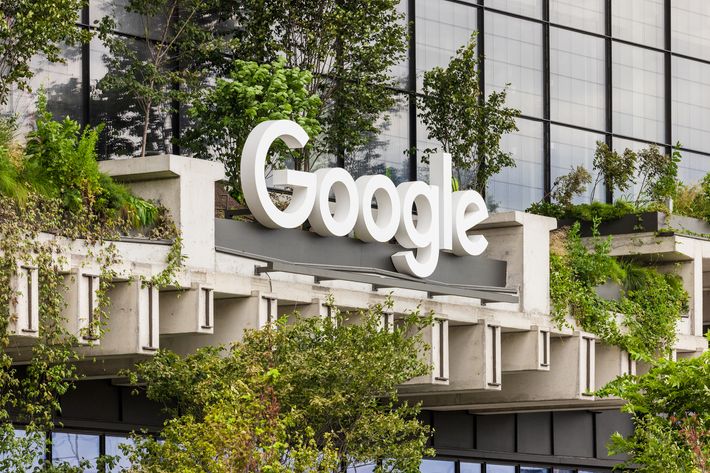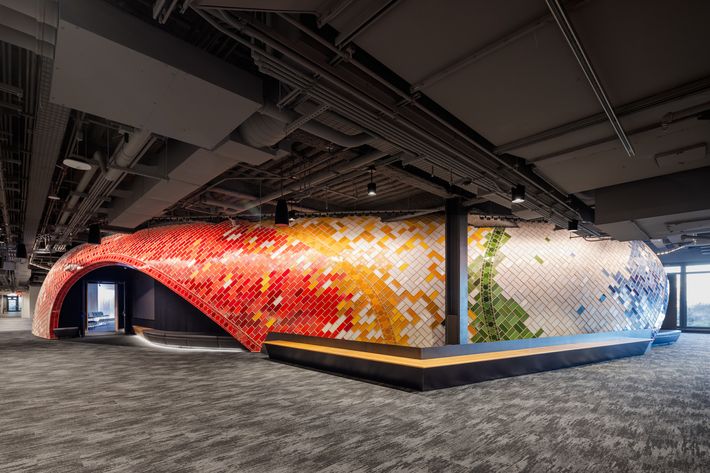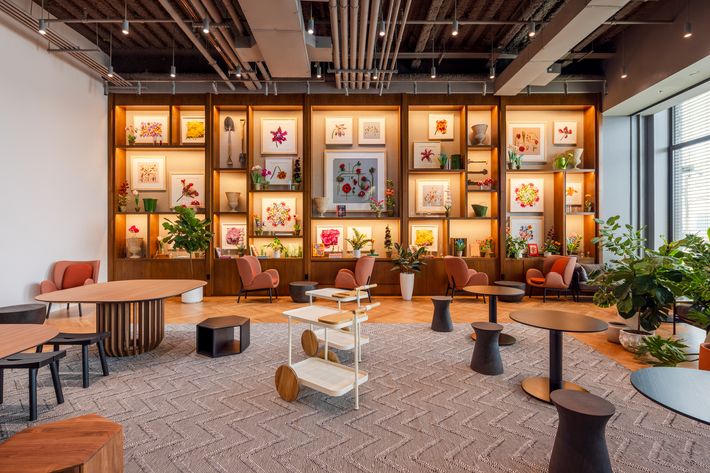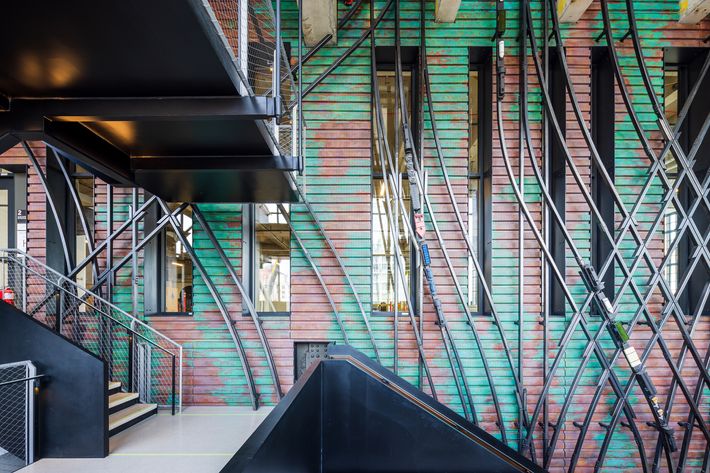Google’s St. John’s Terminal HQ


Nine new stories of Google offices stand atop the old St. John’s Terminal.
Photo: Courtesy of Google
Google has wormed its way so deeply into our brains, our language, and our minute-to-minute lives that it can be hard to remember how large it looms in the physical world. The company’s unquenchable appetite for West Side real estate in Intrepid-size doses has been transformative. In 2008, it took over the mammoth old Port Authority building at 111 Eighth Avenue. Two years ago, it opened another complex with a public rooftop park on Pier 57. And now it’s added another million-plus square feet in, and on top of St. John’s Terminal, a four-block industrial monster that runs along the western edge of Hudson Square, from Spring Street to West Houston Street. To which I can only say, Phew! I mean that in both senses: astonishment at the sheer measurable scale of the enterprise, and relief that it’s yielded some rich and distinctive urbanism.
There was no guarantee that Google’s giant new complex, designed by CookFox with interiors by Gensler and landscaping by Future Green, would turn out this good, or any good at all. Just because a software firm has built the digital world doesn’t necessarily mean it would know what to do with a workmanlike hunk of industrial infrastructure. From the 1930s through the ’50s, St. John’s Terminal functioned as the downtown end of the High Line, which is now a picturesque tool for facilitating Instagram posts but was created to bring food to Manhattanites without killing them along the way. Street-level freight trains, even though they moved slowly and were guided by urban cowboys on horseback, had a habit of running people over. When the terminal opened, newspapers celebrated the end of Death Avenue. It’s good to see the marriage of tech and architecture giving it new life. (The southern portion of the trestle, running between the terminal and Gansevoort Street, was demolished in the 1960s.)
Before the redevelopment of St. John’s Terminal was part of a corporate strategy, it had a civic dimension. The goal was to find the cash that Hudson River Park needed to shore up Pier 40 before it could collapse. Building revenue-generating towers on the pier itself proved politically impossible, but in 2016, the city council passed a bill allowing the park to transfer air rights across West Street, in exchange for a quick $100 million. CookFox came up with a proposal for how to use all that square footage, which made the late critic Michael Sorkin even more irate than he usually was. “Its design is a particularly ripe variation on the ‘form follows finance’ mentality at the core of the way New York City plans,” he wrote in The Architect’s Newspaper, “and is larded with bluff (a big box store, vast amounts of parking, extremely tall towers, and a truly grotesque ‘as of right’ alternative scheme).” Sorkin countered that plan with a speculative proposal of his own, which cleared away what he regarded as architectural clutter and reconnected the neighborhood to the river — but still wound up with three 400-foot residential towers lined up along West Street. It seemed like the city could choose between bad or terrible.
What we got instead, when Oxford Properties bought the site, then rented and eventually sold it to Google, is far better than anyone who followed those byzantine negotiations could have hoped for. The deal preserved most of the original terminal, less as an aesthetic gesture than because all that concrete was just fine. Slabs and columns massive enough to support a train viaduct and wagons loaded with freight now carry a new nine-story building on top. Far from disguising that brute brawn, the architects have surgically exposed it, jackhammering through three-foot-thick floor slabs to make room for a staircase and baring the original columns and beams. The massive old bones are most visible at the building’s north end, where the terminal once leapt across Houston Street, leaving an unpleasant underpass below. The architects sheared off that portion, leaving the cross section exposed. Now the Google logo runs across what was once the railbed, framed by a pair of raised platforms where goods could roll right off the cars. Behind that is a wall of glass, so it almost looks like the façade is missing. The trains, tracks, and platforms are gone, but the concern with efficiently delivering food remains in the demand for ample freight elevators that anchored CookFox’s design. Only now, instead of hauling up sides of beef, they deliver an endless supply of adorable mini-croissants.
You might detect a hint of ruin fetish to this approach, as if a bomb had splintered everything more fragile than a mass of thick concrete that’s preserved in a diorama of damage. But I prefer to see it as an acknowledgment that even a complex swirl of data stored in a notional cloud — a universe that we all inhabit but that didn’t exist within recent memory — takes its place in a city’s physical history. When you reconfigure a building that was once hailed as a technological breakthrough and quickly became obsolete, you’re effectively recognizing that a day will come when people say, “Hey, remember Google?”
The sawn-off bridge that once crossed Houston Street now carries Google’s logo.
Photo: Courtesy of Google
At the Port Authority building, aside from the sign over the door, you can’t really tell that it’s a den of futurists. At St. John’s, the past is just a podium. CookFox laid a long, gray, gridded prism down atop the tan brick terminal, with a slight fold in the center to alleviate the sense of horizontal endlessness. You could practically fit a motorcycle race course in there. But because the new structure is raised, set back, well proportioned, and understated, it tucks right into the West Side cityscape. With the construction equipment and fences gone, I suspect most passersby will assume that the upper floors, too, have been there for decades. The impression strengthens in warm months, when the copious plants on every terrace burgeon, as if nature were reclaiming old masonry.
Interweaving the hard and the living, an essential aspect of modern architecture at least since the Ford Foundation opened in 1967, has lately edged into a fad, embodied by the High Line and frequently accompanied by claims of environmental virtue. Bjarke Ingels Group’s Spiral, near Hudson Yards, applies the principle to the high-rise. Here, it’s more convincing, thanks to the abundance of cultivated terraces, the emphasis on native plants, and the way outdoor workspaces are interlaced with gardens. Google shored up its ecological credibility by hiring Eric Sanderson, the author of Mannahatta: A Natural History of New York City, to oversee the plantings. In key spots, CookFox installed high glass railings to block the gusts that barrel off the Hudson. Employees can theoretically spend the day outdoors without ever leaving the building.
In the early 2000s, Google famously designed its offices so that employees could always postpone going home. These days, it has a tougher task: persuading them to come in at all. Its culture is based on small, close-knit teams whose members can choose how to organize their turf and modify it depending on the task. Presence is half the battle. And on that front, the company’s interests are aligned with the city’s. Manhattan can no longer rely on its appeal to corporate board members and CEOs with the power to locate their headquarters wherever their favorite restaurants are. When so many employees are mobile, New York has to make itself the in-demand worker’s metropolis of choice. One way to lure them is with irresistible workplaces: river views, fresh air, abundant greenery, and joyous, comfortable design (in addition to those adorable mini-croissants). Maybe few people will change careers based on the domed auditorium entry, covered in polychrome Guastavino tiles, that Gensler squeezed like a rubber ball beneath the fourth-floor ceiling, but it’s hard not to look at it and smile.
The entry to the auditorium is covered in polychrome Guastavino tiles.
Photo: Courtesy of Google
The penthouse café is intended as a popular shared workspace.
Photo: Courtesy of Google
A memory of the old rail lines, now vertical instead of elevated, covers a new elevator and stair core.
Photo: Courtesy of Google
Google has moved away from the trickery that disguises the office as the college dorm. Instead of plying coders with foosball tables and ball pits, Gensler has designed an indoor city with looping streets, unexpected plazas, and rooms for every work style, from the conference-table meeting to the slouch-and-hang. That fluid approach descends from the 1960s concept of the Bürolandschaft, or office landscape, in which workers were nudged out of their separate cells and into collaborative huddles on an open floor. That idea eventually evolved into the bullpen, hardened into the cubicle array, or degenerated into the sweatshop setup of workstations running the length of catwalk-like tables. Now, though, Gensler has applied its attention to detail to supercharge the common practices of comfort, of mixing teamwork and privacy, seriousness and informality. If I needed to go off and get some writing done, I would probably choose the soothing penthouse-floor café, with its watery panorama and its wall of botanical prints. But there are plenty of other styles of lair to choose from.
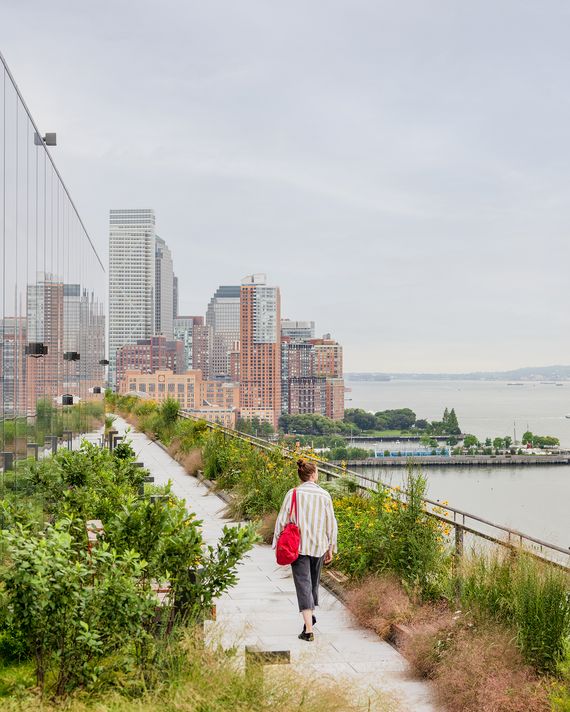
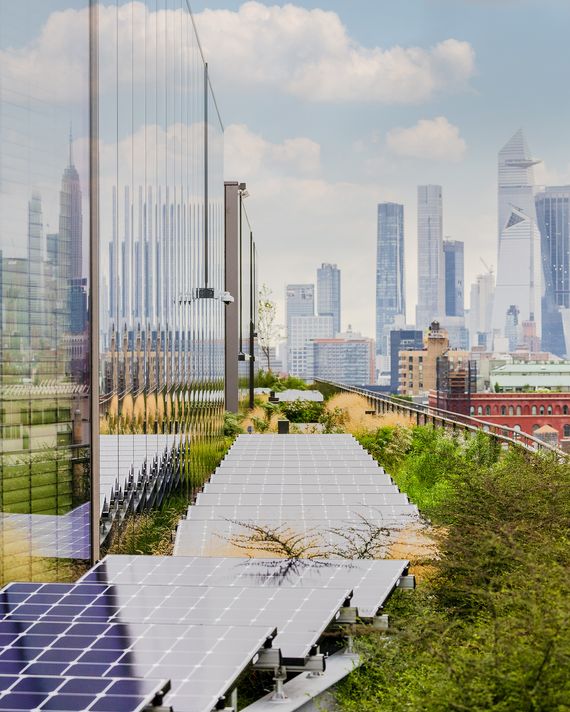
Native plantings soften the architecture’s hard edges. Photos: Courtesy of Google.
Native plantings soften the architecture’s hard edges. Photos: Courtesy of Google.
The perks of office life matter even to those of us who don’t work there. Google’s penchant for spreading out in a dense city has given fresh life to facilities built for shipping and freight rail, keeping portions of the skyline profitably low. It’s brought more than 14,000 employees, plus a steady stream of daily visitors, to an area that might otherwise have leapt straight from postindustrial wasteland to luxury urban suburb. Instead, the company’s milelong urban campus is mixed in with residential neighborhoods, a cultural corridor, a bike artery, assorted parks, and sports venues. Wherever tech sweeps in, the industry brings with it fears that it will distort a market, establish a monoculture, and kill an urban ecosystem. But not even Google can overwhelm Manhattan; there’s just too much else going on.
Source link

